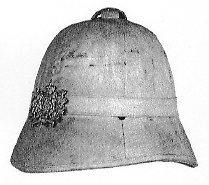
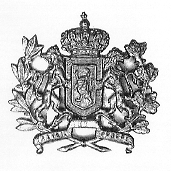
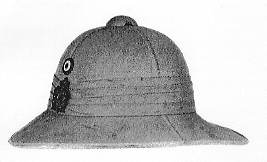
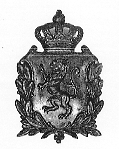
HIS
PAGE IS ALWAYS UNDER CONSTRUCTION, SO PLEASE VISIT AGAIN.
"LA
FORCE PUBLIQUE" OR "DE OPENBARE WEERMACHT" IN THE
BELGIAN CONGO.
E. Uniforms 1914-1918.
 |
 |
 |
 |
|
Old
type "champignon" helmet in use untill 1916.
|
insigna
for "champignon" helmet.
|
"Wolseley"
helmet (from 1916 onwards).
|
insigna
for "Wolseley" helmet.
|
In the period 1909-1914 there was much discussion about the uniform of the Force Publique. Many officers were in favour of the British khaki uniform, mainly for practical reasons (more suitable in the tropics). Vice-Governor-General Wangermée was a stout supporter of this modernisation, but he was countered by his collegue Henry who describes the royal blue uniform as being "one of the most gracious in Africa". Bruneel, commanding the Force Publique, was also in favour of the blue uniform, but he admitted that the red fez made the askaris an easy target. "Therefor, it would be advisable to remove it in combat" (?)... Nevertheless, he agreed with Wangermée that the European's dolman was far from ideal, but at the same time he was opposed to the khaki, because it would become impossible to make the distinction between the British and Belgian forces, particularely in border areas. Several new designs were presented, but nothing concrete ever materialised. In 1914 - a few months prior to the beginning of the war - a royal decree was issued in the "Bulletin officiel du Congo belge": the dolman survived as full dress, but the new service dress was to be a khaki version of the dolman combined with wide knickebockers, puttees or gaithers and the tropic helmet. The outbreak of WWI intervened with the practical follow-up and on 22nd May 1915 (a year after the decission was made) the new uniform was withdrawn. A little on the late side, since the distribution to the troops had already begun. This resulted in a lot of confusion, untill - on 19th April 1916 - it was decided that the European personnel should wear khaki (the same uniform as worn on the Western Front). The old tropic helmet was preserved, but to be replaced by the British "Wolseley" helmet (also in khaki, with the insigna pictured below). The full dress and the service dress were indentical apart from the fabric, but most of the time the jacket was not worn, so the Europeans campaigned in their shirtsleevs (with or without a tie); badges of ranks worn on the shoulderstraps. Since - once more - it proved to be impossible to issue the new uniform to all troops in the Congo, the "blue" uniform was still authorized untill the end of the war although it gradually disappeared (the same problems occured with the changeover from blue to khaki for the natives).
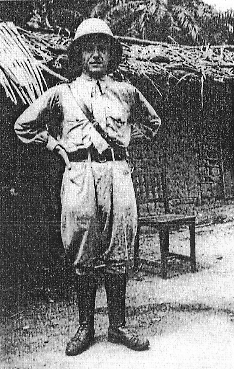 |
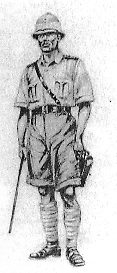 |
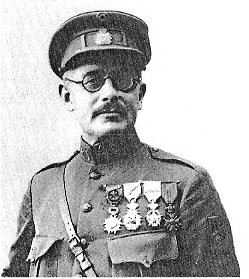 |
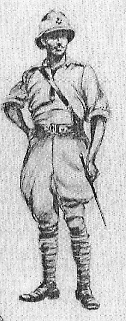 |
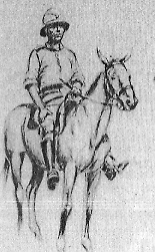 |
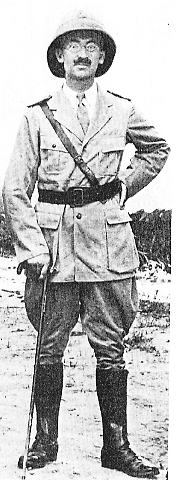 |
|
Officer in khaki service dress.
|
Colonel Olsen.
|
Major Rouling in 1917.
|
Officer in khaki service dress (1916)
|
Mounted officer (1916).
|
Lieutenant-Colonel Huyghé (1917)
|
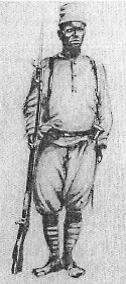 |
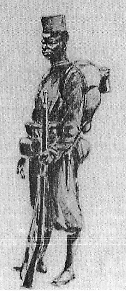 |
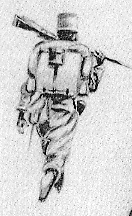 |
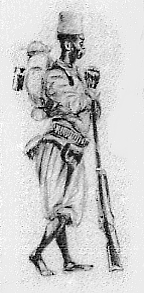 |
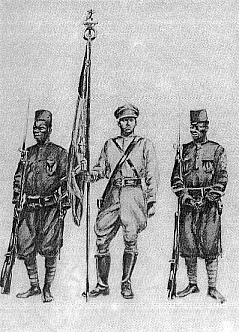 |
|
Askari in khaki uniform.
|
Askari in blue uniform.
|
The backpack (1916).
|
Askari (1916)
|
Colour party of the Force Publique in 1916.
|